

 |
Search the Site with

|
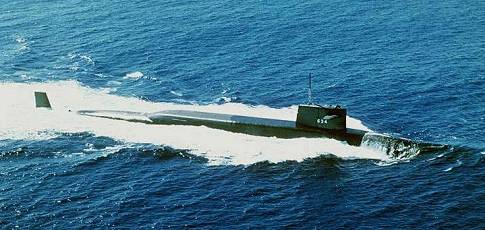 | 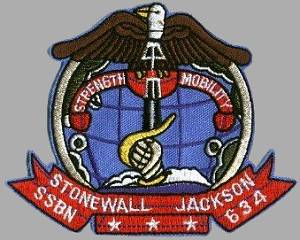 |
USS STONEWALL JACKSON was the 17th LAFAYETTE - class nuclear powered fleet ballistic missile submarine. Decommissioned and stricken from the Navy list on February 9, 1995, the STONEWALL JACKSON subsequently entered the Navy’s Nuclear Powered Ship and Submarine Recycling Program at Bremerton, Washington. Recycling was finished on October 13, 1995.
| General Characteristics: | Awarded: July 21, 1961 |
| Keel laid: July 4, 1962 | |
| Launched: November 30, 1963 | |
| Commissioned: August 26, 1964 | |
| Decommissioned: February 9, 1995 | |
| Builder: Mare Island Naval Shipyard, Vallejo, Calif. | |
| Propulsion system: one S5W nuclear reactor | |
| Propellers: one | |
| Length: 425 feet (129.6 meters) | |
| Beam: 33 feet (10 meters) | |
| Draft: 31.5 feet (9.6 meters) | |
| Displacement: Surfaced: approx. 7,250 tons; Submerged: approx. 8,250 tons | |
| Speed: Surfaced: 16 - 20 knots;Submerged: 22 - 25 knots | |
| Armament: 16 vertical tubes for Polaris or Poseidon missiles, four 21" torpedo tubes for | |
| Crew: 13 Officers and 130 Enlisted (two crews) |
Crew List:
This section contains the names of sailors who served aboard USS STONEWALL JACKSON. It is no official listing but contains the names of sailors who submitted their information.
About the Ship's Name:
Thomas Jonathan Jackson, born at Clarksburg, Va., (now in W. Va.) in 1824, was orphaned at an early age; but, through sheer determination, he acquired a basic education and won an appointment to the United States Military Academy at West Point. He graduated in 1846 and acquitted himself so well during the Mexican War that he was breveted to the rank of major within 18 months. He resigned from the Army in 1852 and became professor of artillery tactics and natural philosophy (physics) at Virginia Military Institute.
At the beginning of the Civil War, Jackson was appointed colonel of Virginia troops and placed in command at Harper's Ferry. He was promoted to brigadier general on 17 June 1861 and quickly brought his command to peak efficiency. At the First Battle of Manassas, as a Federal assault shattered itself against his troops, he became "Stonewall" Jackson when Brigadier General Bernard E. Bee exhorted his own troops to reform by shouting, "There stands Jackson like a stone wall. Rally behind the Virginians!"
On 7 October, Stonewall Jackson was promoted to major general and assumed command in the Shenandoah Valley. Using lightning attacks coupled with strategic retreats, he conducted the masterful Valley Campaign which resulted in resounding Southern victories at Kernstown, Front Royal, and Winchester. He then withdrew south to check Fremont's forces at Cross Keys and Shield's troops at Port Republic. At this point, General Robert E. Lee (q.v.), who had recently succeeded to command of the army standing before Richmond, summoned him to join in the Seven Days Campaign. The Seven Days Campaign ended with the Battle of Malvern Hill on 1 July. McClellan's army withdrew from the Peninsula soon thereafter and Lee's army concentrated on Pope's forces.
After two months of inconclusive skirmishes and maneuvers, Jackson opened a new campaign in late August, when he led his "foot cavalry" on the most famous of all its "rides" and destroyed the Union base at Manassas Junction. During the ensuring Battle of Second Manassas, Jackson was instrumental in overwhelming Pope's army and led the resulting advance into Maryland. He took Harper's Ferry on 15 September and distinguished himself at the Battle of Antietam Creek two days later.
After its withdrawal from Maryland, the Army of Northern Virginia was reorganized into two corps with newly promoted Lieutenant General Jackson in command of the 2nd. His able leadership, based upon ability and strict discipline, was demonstrated again at Fredericksburg, where the Army of Northern Virginia scored another resounding victory in December 1862, this time over General Ambrose Burnside.
Jackson fought his last battle at Chancellorsville, Va., in early May 1863. He succeeded in surprising the rear of General Hooker's army at sunset on 2 May following his last "ride" with his "foot cavalry." Returning from the scene of battle that evening, his staff was mistaken for a Union scouting party in the growing darkness and was fired upon by Confederate pickets. Jackson was severely wounded. Weak from the wound, he contracted pneumonia and died eight days later. Jackson's death, a severe loss to the Confederate Army, deprived it of one of America's greatest soldiers.
USS STONEWALL JACKSON Image Gallery:
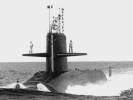 | 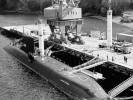 | 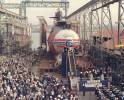 |
 Back to Ballistic Submarines list.
Back to Ballistic Submarines list.  Back to ships list.
Back to ships list.  Back to selection page.
Back to selection page.  Back to 1st page.
Back to 1st page.